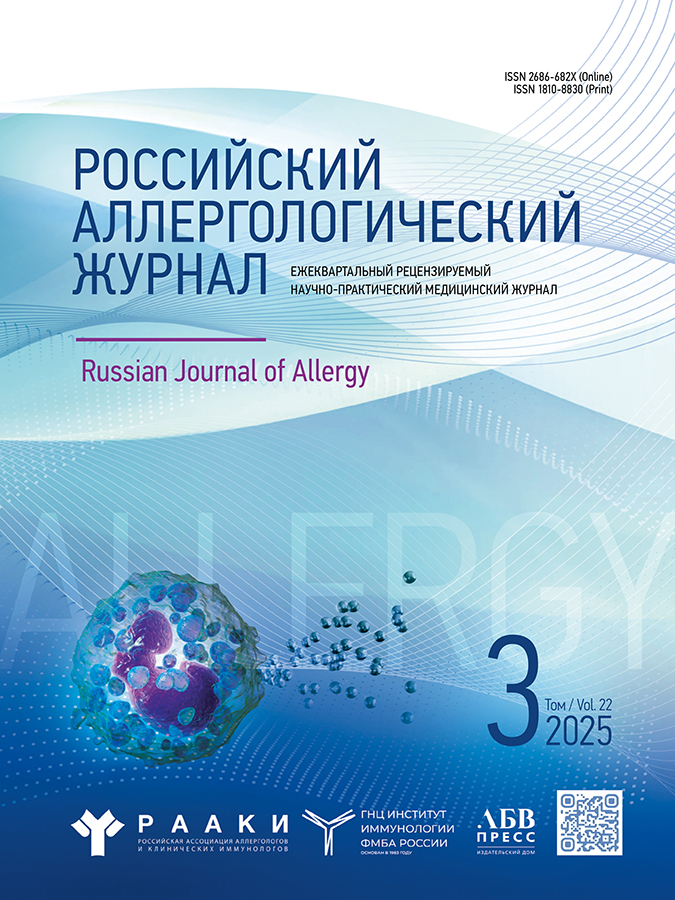IgE-антитела к молекулярным аллергенным компонентам домашних животных у больных с респираторной аллергией
- Авторы: Мокроносова МА1, Басс ЕА1, Бала АМ2, Желтикова Т.М.1
-
Учреждения:
- ФГБУ «НИИ вакцин и сывороток им. И.И. Мечникова»
- Лабораторная служба Хеликс
- Выпуск: Том 12, № 2 (2015)
- Страницы: 25-28
- Раздел: Статьи
- Дата подачи: 10.03.2020
- Дата публикации: 15.12.2015
- URL: https://rusalljournal.ru/raj/article/view/446
- DOI: https://doi.org/10.36691/RJA446
- ID: 446
Цитировать
Полный текст
Аннотация
Ключевые слова
Полный текст
Об авторах
М А Мокроносова
ФГБУ «НИИ вакцин и сывороток им. И.И. Мечникова»
Е А Басс
ФГБУ «НИИ вакцин и сывороток им. И.И. Мечникова»
А М Бала
Лабораторная служба ХеликсСанкт-Петербург
Татьяна Михайловна Желтикова
ФГБУ «НИИ вакцин и сывороток им. И.И. Мечникова»
Email: t-zheltikova@yandex.ru
Список литературы
- Melen E., Wickman M., Nordvall S.L. Influence of early and current environmental exposure factors on sensitization and outcome of asthma in pre-school children. Allergy. 2001, v. 56, p. 646-652.
- Surdu S., Montoya L.D., Tarbell A. Childhood asthma and indoor allergens in Native Americans in New York. Environmental Health: A Global Access Science Source. 2006, v. 5, p. 22.
- Munthe-Kaas M.C., Bertelsen R.J., Torjussen T.M. et al. Pet keeping and tobacco exposure influence CD14 methylation in childhood. Pediatr. Allergy Immunol. 2012, v. 23, p. 747-754.
- Nicolaou N., Yiallouros P., Pipis S. et al. Domestic allergen and endotoxin exposure and allergic sensitization in Cyprus. Pediatr. Allergy Immunol. 2006, v. 17, p. 17-21.
- Ronmark E., Bjerg A., Perzanowski M. et al. Major increase in allergic sensitization in school children from 1996 to 2006 in Northern Sweden. J. Allergy Clin. Immunol. 2009, v. 124, p. 357-363.
- Gusareva E.S., Bragina E.J., Deeva E.V. et al. Cat is a major allergen in patients with asthma from west Siberia. Allergy. 2006, v. 61, p. 509-510.
- Огородова Л.М., Камалтынова Е.М., Деев И.А. и соавт. Эпидемиология аллергического ринита у детей Томска и сельской местности Томской области. Вестник оториноларингологии. 2010, № 3, c. 19-23.
- AWAO-ARIA-GA2LEN consensus document on molecular-based allergy diagnostics. World Allergy Organization Journal. 2013, v. 6, р. 17.
- Nilsson O.B., Binnmyr J., Zoltowska A. et al. Characterization of the dog lipocalin allergen Can f 6: the role in cross-reactivity with cat and horse. Allergy. 2012, v. 67, p. 751-757.
- Желтикова Т.М., Мокроносова М.А. Распространение клещей абарно-зернового комплекса и их роль в сенсибилизации жителей г. Москвы. Бюлл. эксп. биологии и мед. 1991, № 4, с. 396-398.
- Gent J.F., Belanger K., Triche E.W. et al. Association of pediatric asthma severity with exposure to common household dust allergens. Environ. Res. 2009, v. 109, p. 768-774.
- Larenas-Linnemann D., Michels A., Dinger H. et al. Allergen sensitization linked to climate and age, not to intermittent-persistent rhinitis in a cross-sectional cohort study in the (sub) tropics. Clin. Transl. Allergy. 2014, v. 4, p. 20-30.
- Sanchez J., Diez S., Cardona R. Frequency of sensitization to animals in a tropical area. Rev. Allerg. Mex. 2014, v. 61, p. 81-89.
- Nordlund B., Konradsen J.R., Kull I. IgE antibodies to animal-derived lipocalin, kallikrein and secretoglobin are markers of bronchial inflammation in severe childhood asthma. Allergy. 2012, v. 67, p. 661-669.
- Gulbahar O., Sin A., Mete N. et al. Sensitization to cat allergens in non-cat owner patients with respiratory allergy. Ann. Allergy Asthma Immunol. 2003, v. 90, p. 635-639.
- Kelly L.A., Erwin E.A., Platts-Mills T.A. The indoor air and asthma: the role of cat allergens. Curr. Opin. Pulm. Med. 2012, v. 18, p. 29-34.
- Morgenstern J.P., Griffith I.J., Brauer A.W. et al. Amino acid sequence of Fel d 1, the major allergen of the domestic cat: Protein sequence analysis and cDNA cloning. Proc. Natl. Acad. Sci. USA. 1991, v. 88, p. 9690-9694.
- Schmitz N., Dietmeier K., Bauer M. et al. Displaying Fel d 1 on virus-like particles prevents reactogenicity despite greatly enhanced immunogenicity: a novel therapy for cat allergy. J. Exp. Med. 2009, v. 206, p. 1941-1955.
- Emara M., Royer P.J., Abbas Z. et al. Recognition of the major cat allergen Fel d 1 through the cysteine-rich domain of the mannose receptor determines its allergenicity. J. Biol. Chem. 2011, v. 286, p. 13033-13040.
- Gronlund H., Saarne T., Gafvelin G., van Hage M. The major cat allergen, Fel d 1, in diagnosis and therapy. International Archives of Allergy and Immunology. 2010, v. 151, p. 265-274.
- Abramson S.L., Turner-Henson A., Anderson L. et al. Allergens in school settings: results of environmental assessments in 3 city school systems. J. School Health. 2006, v. 76, p. 246-249.
- Permaul P., Hoffman E.B., Fu C. et al. Allergens in urban schools and homes of children with asthma. Pediatr. Allergy Immunol. 2012, v. 23, p. 543-549.
Дополнительные файлы



